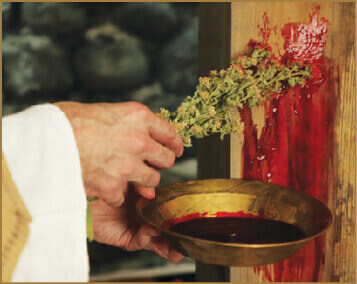Hyssop
The hyssop plant was used anciently in various sacred ceremonies, including rituals associated with the temple. For example, hyssop was utilized in the red heifer sacrifice, specifically, to cleanse someone who’d had contact with a dead body or a grave (see Num. 19:6, 18); Moses used hyssop and other items in a covenantal scene (see Heb. 9:19; Ex. 24:6–8), and hyssop was an important component in the ritual of cleansing the leper and the leper’s house (see Lev. 14:4–6; 14:49–52). Additionally, at Passover, Israelite faithful dipped a clump of hyssop in the lamb’s blood and struck their door’s two side posts and lintel to prevent the destroyer from smiting them (see Ex. 12:23).
The Psalmist provided the symbolic significance of hyssop: “Wash me thoroughly from mine iniquity, and cleanse me from my sin. . . . Purge me with hyssop, and I shall be clean: wash me, and I shall be whiter than snow” (Ps. 51:2, 7; see also Ps. 26:6).

Using hyssop to place lamb’s blood on door posts (modeled here) kept the destroyer away.